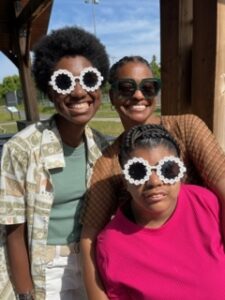Lisa T., Dorian’s Mom
On January 17, 2001, Dorian was diagnosed with CdLS after her pediatrician noticed that she had only gained four pounds since birth despite being breast-fed. Despite not showing any limb abnormalities, Dorian’s slow growth raised concerns, and a specialist confirmed the diagnosis.

One thing that is etched into my spirit was the neuro-specialist we saw that day.
During the visit, the specialist completed a physical examination – he held Dorian, weighed her, turned her over, gave her back to me, and said, “Your daughter has Cornelia de Lange Syndrome, named after the person who discovered it. It’s children with similar facial features, thick eyebrows, long lashes, and small head sizes. Some have limb abnormalities and gastrointestinal issues; many are non-verbal and experience hearing loss or are deaf and are often retarded or have significant cognitive and developmental delays. You will be responsible for her care for the rest of her life as she will require a great deal of supported care.”
He then began to rummage around in his drawer, mumbling about having a brochure from the CdLS Foundation, but could not find it. He wrote it on an orange Post-it and passed it to my husband. I could not take it because I was shaking so badly. My husband had to grab it and Dorian. The doctor left the room, and his assistant returned and stated she could understand how this news could be “upsetting and would follow up later with a call and next steps.” My husband, a physician, later joked, “I wonder how that guy passed bedside manners!” as we sat in the office parking lot and cried for 22 minutes.

Despite the initial hurdles, Dorian has surpassed expectations and become a source of joy for her family.
However, her ongoing care presents challenges, from accessing essential services to concerns about her vulnerability.
When we registered for our first CdLS Clinic at GBMC, we were searching for answers. It seemed like we were only addressing the symptoms and not the root cause of many of her issues. Because of the size of her mouth, she needed a frenulum clip. Although they were able to intubate her successfully, the anesthesiologist and his staff had never encountered CdLS. They recommended that we conduct further research on her skeletal structure due to some dental issues they had noticed, which would require sedation.
Fortunately, the CdLS Clinic at GBMC has provided invaluable support and information.
Our participation in the Multidisciplinary Clinic at GBMC has equipped us with educational resources and a deeper understanding of CdLS, along with tailored medical insights for Dorian’s specific needs.
Dorian’s vibrant personality shines through as she embraces life with enthusiasm. She enjoys dressing up, making jokes, and connecting with others in her unique way.

Recent Comments